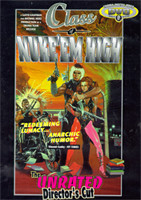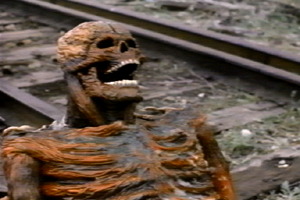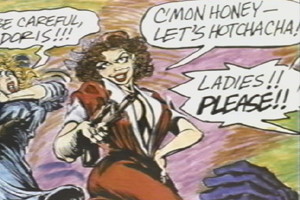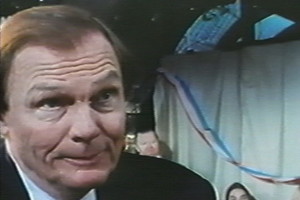| INTERVIEW WITH RICHARD HAINES
|
|
 | Richard is probably best known for directing Class of Nuke 'Em High, but he has an impressive resume in budget film making and has earned praise for his book on the Technicolor film process. Mr. Haines' book, The Moviegoing Experience, 1968-2001 is available from Amazon.com.
Interview Date: 9 November 2000
|
|
| Andrew:
| I see that you have written and directed three films, worked as an editor on several, and written a book on Technicolor which seems to be well taken (though I have not had the pleasure of reading it). When did you begin getting into movies and was the lower budget genre your interest or just the way things turned out?
|
| Richard Haines
| I've written and directed six films. "Unsavory Characters" (2000); "Run for Cover in 3-D" (1995); "Head Games" (1993); "Space Avenger" (1991); "The Class of Nuke 'Em High" (1986) and "Splatter University" (1983). Aside from editing my own features, I cut the following Troma pictures, "Stuck on You" (co-edited) (1982); "The First Turn On" (1983) and "The Toxic Avenger" (1985).
My book, "Technicolor Movies: The History of Dye Transfer Printing" was published in 1993 by McFarland and Company. I wrote two articles for the (defunct) Perfect Vision magazine, "The Return of Glorious Technicolor" and "Restorations or Alterations". I also wrote two articles for Widegauge Film and Video Monthly, "Run for Cover in 3-D" and "3-D Festival in Tel Aviv". My most recent article, "Technicolor Revival," will appear in the next issue of "Film History" (published by Rutgers University).
|
| | I was always into movies and spent most of my youth glued to the TV set or at matinees in my local cinema. The rest of the time I read Marvel comic books or underground comics like "Head" and "Zap". In my youth, (sixties and early seventies), the screens were large and many of the prints were in Technicolor. I liked to sit in the second row so the image would overwhelm me. (I would not advise watching movies today this way because the screens are so small and the Eastman color prints so grainy). I enjoyed movies that were made solely for entertainment and disliked 'message' films that preached to you. For example, I had my parents drop me off at a Bond double bill and stayed from the matinee until the last performance, watching the films two or three times. I also enjoyed low budget horror films (i.e. "Night of the Living Dead", "Last House on the Left") at the Hollowbrook Drive-in in Peekskill. I was a 3-D fan and saw the revivals of "House of Wax," "Creature from the Black Lagoon" and "It Came from Outer Space". Sadly, everything I used to enjoy about Cinema is gone today including large screens, Technicolor (it's available again but no one uses it) and drive-ins.
I had a Super 8 camera in my teens (later Super 8 sound) and would make short films. I used to animate Action Figures (i.e. Captain Action, GI Joe) and robots (i.e. Zeroids) using the stop motion technique which is not possible on video. Later, I made student films at NYU and finally made my first low budget feature in 1981 (released in 1983). You might say I was always in production from age 12 to age 43.
What I've tried to do in my film-making career is to revive the type of films I saw when I was a kid. For example, I combined my love of comic books and drive-in exploitation films into "Space Avenger". I even went to China in 1989 (two weeks after the political turmoil) to make 3 strip Technicolor prints of the film to simulate the vivid primary colors of the movies I saw growing up. My memories of "House of Wax" inspired me to make my fourth film, "Run for Cover," in the StereoVision 3-D process. I hired Adam West to star because I was a fan of his TV show decades ago. My latest film, "Unsavory Characters", is a homage to the 'film noir' movies I saw on television and in revival theaters in the seventies.
|
| | Quite frankly, I enjoy the autonomy of independent film-making. The financial risk is low and I'm not subject to the political pressures of Hollywood directors. If "Space Avenger" had been financed by a studio, there's no way they would've agreed to print it in Technicolor. As it turned out, the use of dye transfer technology generated publicity and sales.
| |
 | "I even went to China in 1989 (two weeks after the political turmoil) to make 3 strip Technicolor prints of the film to simulate the vivid primary colors of the movies I saw growing up."
Note from Andrew: The VHS authoring and video capture might spoil some of the effect, but the richness of color is still apparent in "Alien Space Avenger."
|
|
| Andrew:
| Have you ever thought about making a pure and simple monster movie? I'm talking classic B&W drive-in fare, they were my absolute meat and potatoes growing up. Saturday's "Double Creature Feature" on Channel 29 out of Philadelphia.
|
| Richard Haines
| In a sense, "The Class of Nuke 'Em High" was a monster movie with the mutant fetus on the loose through the second half. At this point in time, I'm not interested in making a fifties style one at least in part because I can't afford the digital special effects that would be required.
| |
| Andrew:
| Your knowledge of Technicolor is impressive and obviously born of a love affair with the visuals it creates. Was your major at New York University in film or was that a hobby?
|
| Richard Haines
| I was a film major at New York University from 1975-1979 and received a BFA. My minor was music. I studied with Haig Manoogian (Martin Scorsese's mentor) and director Chris Columbus ("Home Alone" etc.) was in some of my classes. I also studied with film historian William K. Everson who was a Technicolor advocate and took some courses at The School of Visual Arts with Leonard Maltin years before he became a celebrity on Entertainment Tonight. In fact, when I contacted my former film teacher and told him I'd make a Technicolor film, he did a whole segment on it on the show. Film was also my hobby. I had become a film collector in my teens and used to give outdoor drive-in type shows in my girlfriend's back yard including "Night of the Living Dead" complete with Filmack intermission reel. I also collected film books and ended up with an extensive library.
| |
| Andrew:
| If someone were to ask you about your crowning achievement what would it be?
|
| Richard Haines
| The crowing achievements in my career would have to be my current feature "Unsavory Characters", my use of Technicolor in "Space Avenger", the 3-D visuals of "Run for Cover" and my book. Regarding the former, it's a complete break from my earlier exploitation pictures. The performances are very professional and I was able to replicate the B&W visuals of the noir genre. I actually looks like an RKO film from the late forties compared to current noir features.
| |
| Andrew:
| In regards to "Unsavory Characters," does the movie come across as suspense or situational horror? In fact, can you give us a general plot synopsis?
|
| Richard Haines
| "Unsavory Characters" is a suspense film full of plot twists. It's a variation of the 'life imitates art theme' I used in "Space Avenger". In the case of the former, it was about a comic book artist trying to come up with new villains for his latest issue. He discovers real life Alien Terrorists and uses his experience to illustrate the magazine. In the new film, the hero is a pulp fiction writer along the lines of Mickey Spillane. He has to come up with an ending to his new novel to get the advance. Seeking inspiration, he picks up a 'femme fatale' in a bar who seduces him into murder and intrigue. He uses his adventure to complete the manuscript.
In "Space Avenger" I simulated the look of a comic book by making Chinese dye transfer (Technicolor) prints. In the new film there are scenes which dramatize the novel the writer's working on. I shot them in black and white in the 'film noir' style. The rest of the film is in color. I discovered a formula for 'noir'. You scrim down the key light on your actor's face so that part of it is in darkness. Rather than filling in the shadows of the background, you leave them which makes the set look sinister and bounce an inky off the back of the actor's head to give a sense of dimension. You also need to shoot at a high f-stop to generate a sharp depth of field (foreground and background sharpness).
| |
 | "In 'Space Avenger' I simulated the look of a comic book by making Chinese dye transfer (Technicolor) prints. In the new film there are scenes which dramatize the novel the writer's working on."
|
|
| Andrew:
| Have there been any hard lessons learned over the years? Casting, writing, etc. - anything you would look out for a second time around?
|
| Richard Haines
| The hardest lesson for any filmmaker is dealing with distributors and agents. For example, I was involved with the restoration and marketing of "Carnival of Souls" in 1989-1991. We signed with FilmStar as our foreign rep. They had a huge office in Los Angeles with an international staff to help negotiate deals. We received a statement that they had secured large advances in Germany and England. I never saw a penny because when we went back to their offices, the company had folded and disappeared. I don't want to suggest all distributors are like this. I had good relationships with Walter Manley (my rep on "Splatter University" and "Space Avenger") and Jerry Balsam (my rep on "Head Games"). They secured excellent deals and paid me. Unfortunately, both passed away. In summary, you have to be very careful who you do business with.
| |
| Andrew:
| How does your family react to "The Class of Nuke 'Em High" or your other movies? (On a side note, my sister still shakes her head in amazement whenever I pull a b-movie out for "family entertainment.")
|
| Richard Haines
| My family has invested in all of my films and are very supportive. My parents helped finance "Splatter University" and made some money with it. My wife wrote the screenplay from my current film and also assisted in the financing. I guess you might say most of my productions are 'in house'. Regarding the content, my parents and wife like "Space Avenger", "Run for Cover" and "Unsavory Characters". Everyone I hang out with likes "B" movies which can be very entertaining, regardless of budget. In some cases, the low budget works in the film's favor (i.e. "Carnival of Souls"). Independent filmmakers tend to be more daring since the financial risk is far less than if you're squandering one or two hundred million dollars on a project. I'm more impressed with someone who has made an interesting little picture with good acting and production value for under a million than watching "The Postman" or "Waterworld" and scratching my head wondering where all that cash went.
| |
| Andrew:
| You must deal with a number of entirely unknown actors in making your films. What are your experiences with that? Diamonds in the rough? Pin the tail on the donkey?
I often think that someone being paid several million dollars to act in a movie is a crime. Do you think the elite professional actors which rule Hollywood these days is a bad thing?
|
| Richard Haines
| The best acting to date is in my current feature. Eric Leffler plays the writer, Jacqueline Bowman makes a terrific 'femme fatale' and Anthony Peraticos a sadistic villain. In my previous films the performances tend to be uneven with some of the actors quite good and the others mediocre. Fortunately, I edit my films so the pacing is very rapid and the so-so performances go by quickly. In my last film I used some name players, Adam West and Viveca Lindfors. They were excellent in their roles but tended to make my nonprofessional actors seem somewhat amateurish in comparison. In some cases this worked to the advantage of the story. The campy performances in "Space Avenger" made the movie seem like a live-action comic book.
Regarding actor's salaries, they are outrageously high but obviously the studios wouldn't pay them if they couldn't generate enough revenue to show a profit. From a business perspective, the studio system made more sense. Get your top talent (actors, directors, cameramen etc.) under seven year contracts where you can control costs. They in turn get job security, prestige and incredible coworkers to make great feature films.
Of course, this only worked when the studios owned the theaters they played their product in. After the 1948 consent decree which forced them out of exhibition, the system fell apart and everyone became an independent contractor. The fees were higher but so was the risk. There was no job security and you were only as good as your last big budget film. If it performed poorly, you were finished. In the studio system, you could weather a few bombs and make a quick comeback because everyone was making so many pictures a year. None of this applies to the low budget field in which you have to hustle for everything.
| |
 | "In my last film I used some name players, Adam West and Viveca Lindfors. They were excellent in their roles but tended to make my nonprofessional actors seem somewhat amateurish in comparison."
|
|
| Andrew:
| Are you currently working on anything?
|
| Richard Haines
| We're making our first answer print of "Unsavory Characters" and are looking for an agent to represent us. My next project is a heist film with a political twist tentatively entitled, "The Root of All Evil". I plan on shooting it in the anamorphic process.
| |
Anyone seeking further information should read his Internet Movie Database profile. I'd like to thank Richard for taking time to answer these questions, plus wish him luck with "Unsavory Characters" and any future endeavors.
|
|
